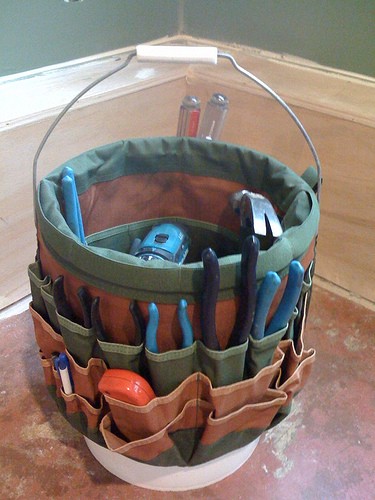This semester, I’m piloting a methods class in our department. Well, really, I’m kind of co-piloting it; after lots of departmental conversation and some rough planning last year, a colleague of mine wrote the first version of the syllabus and taught it last term as a hybrid class in the night school with half MA students and half undergrads. The plan is for the course to be required for all of our majors and minors starting next academic year, so this year we’re giving the course a couple of dry runs with smaller enrollments (read: students who are taking it out of interest, not because it’s a requirement). And I’ve got it this term (Spring 2011).
The course is named after, and somewhat patterned upon, “The Historian’s Craft” at UConn, described by Nancy Shoemaker in an article for the January 2009 AHA Perspectives, “Where is the History Lab Course?” That article came out just as we were designing ours and we found it most helpful. We didn’t adopt their semester-long historical investigation that results in a crowdsourced monograph project (although that’s a very cool model), but we did design ours as a hands-on “lab” course. And we managed to snag the course number “History 411,” which we thought was most appropriate.
In April 2011, our university is hosting the New England Historical Association (NEHA) and I’ll be part of a roundtable panel on pedagogy of the historical methods class (do come if you’re in Worcester on April 16th!), and I thought in advance of that session I’d pull together some of our initial experiences and thoughts in creating, and beginning to teach, a course in the historian’s craft. Perhaps my transparency can benefit others who are engaged in that same process.
First, some resources:
- my version of the syllabus for Spring 2011
- the course website, also for Spring 2011 (a WordPress blog)
- a PDF of the “back end” material for the course instructors
Initially we decided the course would be a kind of “tool bucket” of skills and hands-on assignments that we’d pass from person to person as the responsibility for teaching the course will rotate,  and into that bucket can be inserted the instructor’s own strengths, interests, and content. The “back end” document linked above contains a menu of the course’s possible student learning outcomes, a list of potential workshops for the middle section of the course, a basic outline for the semester, and designates one paper assignment as an “embedded program assessment” which would be the same from term to term regardless of the instructor.
and into that bucket can be inserted the instructor’s own strengths, interests, and content. The “back end” document linked above contains a menu of the course’s possible student learning outcomes, a list of potential workshops for the middle section of the course, a basic outline for the semester, and designates one paper assignment as an “embedded program assessment” which would be the same from term to term regardless of the instructor.
As we redesigned our program requirements for majors and minors to insert this new required course, we gave “Historian’s Craft” four prerequisites, all of them 100-level surveys – with the hope that a) we’d be nudging our students to take those early in their program rather than later, and b) all students in our programs would be passing through this course at something close to mid-program, so we could use the course as a “middle snapshot” program assessment and a stepping stone to our (future) senior capstone.
Structure: three big units, each with a paper due at the end based on a topic of the student’s own choosing (within reason – e.g. since I’m an American historian, I’m asking them to keep to a topic within US history). Students can choose 3 different topics or keep the same one for each unit. Also, I’m having each student create a simple e-Portfolio using Google Sites, and post weekly journal entries there.
Unit 1, “Don’t Know Much About History” (cue Sam Cooke) is about how textbooks treat their chosen topic, and uses James Loewen’s Lies My Teacher Told Me to critically analyze a standard survey textbook (after teaching at a State U for 3 years, I have enough freebies and publisher’s comps to lend one to every student in my class for the duration of the unit). It will also engage questions of history standards, textbook controversies, historical writing, citation/plagiarism, and other thorny issues around historical authorship.
Unit 2 is “The Practice of History as Craft” and has five in-class, hands-on “labs” or “workshops” having students locate, analyze, critique, manipulate, or make historical evidence. The actual format and content of those workshops is somewhat flexible depending on who’s teaching: mine are Quantitative data, Private Papers, Government Docs (either Congressional hearings or Supreme Court cases, probably), Radio Programs, and Maps. Our main reading throughout this section is Robert C. Williams, The Historian’s Toolbox: A Student’s Guide to the Theory and Craft of History.
Unit 3, “The History Profession/ Professing History” will be more about the broader discipline and profession of history, including a sprinkling of historiography and then weeks on film, public history/museums, historical memory, and history on the internet.
Throughout the coming semester, I’ll be posting occasionally my “field notes” on how the course is going, what works & what doesn’t, what’s a keeper and what I’d like to do differently next time around. Just trying to be methodical.
(Tool bucket image by tornatore, used under Creative Commons license)













